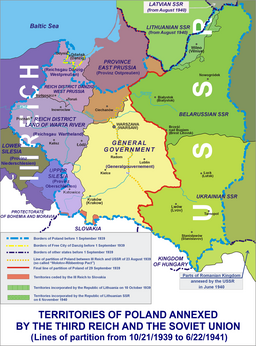
Back المناطق البولندية التي ضمتها ألمانيا النازية Arabic Territorios polacos anexionados por la Alemania nazi Spanish مناطق انضمامی لهستان به خاک آلمان نازی Persian Territoires polonais annexés par le Troisième Reich French Wilayah Polandia yang dianeksasi Jerman Nazi ID Aree polacche annesse alla Germania nazista Italian Pengilhakan kawasan Poland oleh Jerman Nazi Malay Terytoria Polski anektowane przez III Rzeszę Polish Territoret polake të aneksuara nga Gjermania Naziste Albanian Пољске области које је припојио Немачки Рајх Serbian
| Polish areas annexed by Nazi Germany | |
|---|---|
 In darker colours, Polish territories annexed by Nazi Germany and the Soviet Union with semi-colonial General Government in light yellow (centre) | |
 Fourth Partition of Poland – The Nazi–Soviet Pact |
| Territorial evolution of Poland in the 20th century |
|---|
| Territorial evolution of Germany in the 20th century |
|---|
Following the Invasion of Poland at the beginning of World War II, nearly a quarter of the entire territory of the Second Polish Republic was annexed by Nazi Germany and placed directly under the German civil administration. The rest of Nazi-occupied Poland was renamed as the General Government district.[1] The annexation was part of the "fourth partition of Poland" by Nazi Germany and the Soviet Union, outlined months before the invasion, in the Molotov–Ribbentrop Pact.[2]
Some smaller territories were incorporated directly into the existing Gaue East Prussia and Silesia, while the bulk of the land was used to create new Reichsgaue Danzig-West Prussia and Wartheland. Of those, Reichsgau Wartheland was the largest and the only one comprising solely the annexed territory.[3]
The official term used by the Nazi authorities for these areas was the "incorporated Eastern territories" (German: Eingegliederte Ostgebiete).[4] They planned for a complete Germanization of the annexed territories, considering them part of their lebensraum.[5] The local Jewish population was forced to live in ghettos, and was gradually deported to concentration and extermination camps, the most infamous of which, Auschwitz, was located in annexed East Upper Silesia. The local Polish population was to be gradually enslaved, exterminated and eventually replaced by German settlers. The Polish elite especially became subject to mass murder,[6] and an estimated 780,000 Poles were subject to expulsion, either to the General Government or to the Altreich for forced labour. The remaining Polish population was strictly segregated from the German population and subject to a variety of repressive measures. These included forced labour and their exclusion from all political and many cultural aspects of society. At the same time, the local German minority was granted several privileges, and their number was steadily raised by the settlement of ethnic Germans, including those displaced by the Nazi-Soviet population transfers.[7]
After the Vistula–Oder Offensive in early 1945, the Soviet Union took control over the territories. The ethnic German population either fled the Red Army or were later expelled and the territories became part of the People's Republic of Poland.
- ^ Polish Ministry of Foreign Affairs, "German Occupation of Poland" (Washington, D.C.: Dale Street Books, 2014), pp. 12–16.
- ^ Maly Rocznik Statystyczny (wrzesien 1939 – czerwiec 1941), Ministerstwo Informacji i Documentacji, London 1941, p.5, as cited in Piotr Eberhardt, Political Migrations in Poland, 1939–1948, Warsaw 2006, p.4 "Archived copy" (PDF). Archived from the original (PDF) on 2011-10-18. Retrieved 2016-02-08.
{{cite web}}: CS1 maint: archived copy as title (link) - ^ Czesław Łuczak (1987). Położenie ludności polskiej w Kraju Warty 1939–1945. Dokumenty niemieckie. Poznań: Wydawn. Poznańskie. pp. V–XIII. ISBN 8321006329. Google Books.
- ^ The Avalon Project: Documents in Law, History, and Diplomacy. Nazi Conspiracy and Aggression Volume 1 Chapter XIII – Germanization and Spoliation. Yale Law School, Lillian Goldman Law Library. Avalon Project : Nazi Conspiracy and Aggression – Volume 1 Chapter XIII – Germanization and Spoliation
- ^ "Poles: Victims of the Nazi Era Archived 2013-03-03 at the Wayback Machine"
- ^ Cite error: The named reference
crywas invoked but never defined (see the help page). - ^ Polish Ministry of Foreign Affairs, "German Occupation of Poland" (Washington, D.C.: Dale Street Books, 2014), pp. 16–45.